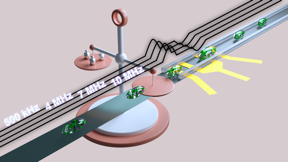Home > Press > From outside to inside: A rapid and precise total assessment method for cells: Researchers at Nara Institute of Science and Technology show that using four frequencies of applied voltage can improve the measurement of cell size and shape during impedance cytometry, enabling to en
 |
| Precise total assessment of the cells with impedance signals.
CREDIT Tao Tang, Yaxiaer Yalikun |
Abstract:
Having a good eye for detail is an essential skill for many professions. In particular, biologists use special techniques and advanced technology to analyze individual cells with unprecedented precision. Impedance cytometry is one experimental method that can reveal specific characteristics of living single cells. This technique requires electrical penetration, in which high-frequency current can freely pass through the cell membrane, without damaging the cell. Now, researchers from Japan have determined optimal conditions to perform impedance cytometry. Their work may lead to rapid assessment of cells during culture in biological experiments.
From outside to inside: A rapid and precise total assessment method for cells: Researchers at Nara Institute of Science and Technology show that using four frequencies of applied voltage can improve the measurement of cell size and shape during impedance cytometry, enabling to en
Ikoma, Japan | Posted on June 24th, 2022
An improved method for measuring the morphology and biomass of single cells using impedance cytometry has been introduced in a recently published study in Microsystems & Nanoengineering. Impedance cytometry involves applying high-frequency voltages to electrodes to measure complex impedance, which can provide information about the shape and effective volume of the cell. In the study, researchers led by Nara Institute of Science and Technology used different phases of voltage signals at four frequencies. They showed that applied voltages with frequencies of around 7 MHz are able to pass through the membrane of Euglena gracilis cells. Higher frequencies can monitor changes in biomass, while lower frequencies can track volume changes.
When a high-frequency electrical field penetrates the cell membrane, the uneven intracellular distribution tilts the impedance pulses to the left or right, which has been verified in simulation and experiments. Ultimately, our method for determining the conductivity of the cell membrane relies on the degree of tilt caused by the electrical pulses, says author Yoichiroh Hosokawa. The team also performed calibration studies using beads to better understand the underlying physical mechanisms of this effect.
This research enables the easy determination of the electrical penetration of a cell membrane, and the proposed platform is applicable to multiparameter assessment of the organisms state during cultivation, says senior author Yaxiaer Yalikun. This platform may be easily integrated into microfluidic systems for the scalable monitoring of biological experiments.
The need for efficient and highly accurate analysis of living single cells may be met by this new impedance cytometry method developed by the research team led by Nara Institute of Science and Technology. Future applications could be extended to cells in mammals to monitor specific membrane changes in fields such as oncogenesis and cell aging.
####
For more information, please click here
Contacts:
Takahito Shikano
Nara Institute of Science and Technology
Copyright © Nara Institute of Science and Technology
If you have a comment, please Contact us.
Issuers of news releases, not 7th Wave, Inc. or Nanotechnology Now, are solely responsible for the accuracy of the content.
![]() Information about the Bio-Process Engineering Laboratory can be found at the following website:
Information about the Bio-Process Engineering Laboratory can be found at the following website:
News and information
![]()
New technology helps reveal inner workings of human genome June 24th, 2022
![]()
Boron nitride nanotube fibers get real: Rice lab creates first heat-tolerant, stable fibers from wet-spinning process June 24th, 2022
Possible Futures
![]()
New technology helps reveal inner workings of human genome June 24th, 2022
![]()
Boron nitride nanotube fibers get real: Rice lab creates first heat-tolerant, stable fibers from wet-spinning process June 24th, 2022
Nanomedicine
![]()
New technology helps reveal inner workings of human genome June 24th, 2022
![]()
New nano-gel to protect children receiving chemotherapy from hearing loss June 17th, 2022
Discoveries
![]()
New technology helps reveal inner workings of human genome June 24th, 2022
![]()
Boron nitride nanotube fibers get real: Rice lab creates first heat-tolerant, stable fibers from wet-spinning process June 24th, 2022
Announcements
![]()
New technology helps reveal inner workings of human genome June 24th, 2022
![]()
Boron nitride nanotube fibers get real: Rice lab creates first heat-tolerant, stable fibers from wet-spinning process June 24th, 2022
Interviews/Book Reviews/Essays/Reports/Podcasts/Journals/White papers/Posters
![]()
Quantum network nodes with warm atoms June 24th, 2022
![]()
New technology helps reveal inner workings of human genome June 24th, 2022
Nanobiotechnology
![]()
New technology helps reveal inner workings of human genome June 24th, 2022
![]()
New nano-gel to protect children receiving chemotherapy from hearing loss June 17th, 2022
![]()
Small materials may be key to reducing cardiovascular disease deaths, researchers say June 10th, 2022










